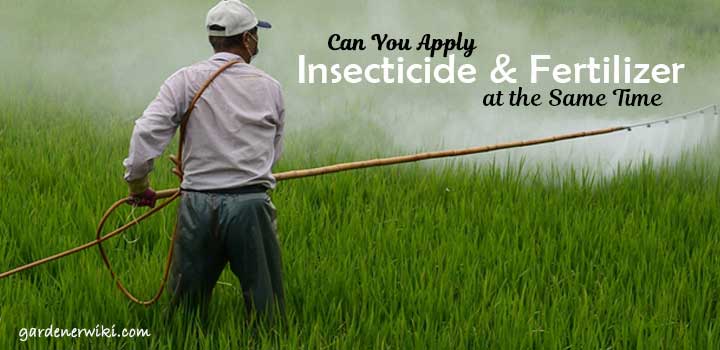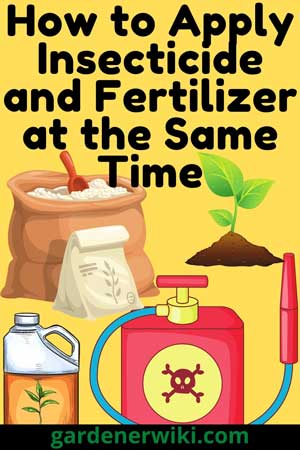Have you ever thought about how much time, money, and effort you can save just by applying insecticide and fertilizer simultaneously?
Both fertilizer and insecticide are incredibly important for a healthy lawn or farm for plant nourishment and killing off the growth hindering and diseases spreading insects.

So, herein comes the question, can you apply insecticide and fertilizer at the same time? Well, yes, that’s perfectly doable and legal, but only if the product labels say so.
If it doesn’t say anything, you can do a physical compatibility test. And this article presents a demonstration of the procedure in elaborate and in-depth insight into fertilizer, insecticide, and other pesticide applications and whether or not you can mix one with another.
Insecticide and Fertilizer Compatibility
Mixing pesticides and fertilizers has been a common practice in many farms. As fertilizer and some pesticide applications require the same equipment, labor, and time, combining the procedure reduces the work to half.
And pesticide labels usually come with a compatibility chart showing which chemicals combine well, form a smooth mixture, and are safe for a tank mix.
However, oftentimes you may not find the information required for the formulation you want to make in the labels. In that case, you can do a compatibility test of the two or more chemicals needed for your formulation.
Compatibility Test
Incompatible solutions don’t mix well and might form separation, flakes, crystals, or clumps. To make sure the ingredients you intend to mix are compatible and form a uniform mixture, you can follow the standard 2-Jar test.
- You will need 2-quart jars for the Jar test and add a compatibility agent to one jar measuring two pints per 100 gallons of your spay mix or ¼ tablespoon. Make sure each of the jars contains one pint of the carrier that is liquid fertilizer or water.
- If you are making a wet formula, make a teaspoon measurement that is equivalent to one pint per 100-gallon spray mix.
- Next, add each of the ingredients to the jars one by one according to the measurement.
- While adding, make sure you use the proper order. The water-soluble concentrates, dry flowables, solutions, and wettable powder goes first and are followed by emulsifiable and suspended concentrates. Add other adjuvants and surfactants at last.
- Now, thoroughly mix all the ingredients by shaking and stirring for about 15 to 45 minutes.
- After that, check for the signs of incompatibility like flakes, clumps, layer separation, and heat emission. If there are no such signs in the jar without the compatibility agent, then it can be concluded that the ingredients are compatible.
- You can compare the first jar with the second one containing the compatibility agent. The agent helps in making a uniform mixture that otherwise wouldn’t be compatible.
Can You Apply Insecticide and Fertilizer at the Same Time?
Yes, you can. In fact, it’s a widely used method across many farms that minimizes cost and labor to a great extent. However, you need to have some basic knowledge of what you can and can’t tank mix.
Fertilizers supply the 6 macronutrients and 3 micronutrients needed for the growth and health of the plant. The macronutrients include potassium, nitrogen, phosphorus, magnesium, calcium, sulfur, and the micronutrients comprise zinc, iron, and copper.
Now, not all of the fertilizers are appropriate for tank mix with insecticides and other pesticides. In addition, supplement and pesticide combination guidelines are fairly limited. That’s why most farmers and gardeners go through many trials and errors before coming up with a good spray combination.
Nevertheless, supplements like potassium nitrate, magnesium sulfate, urea, and glucoheptonate chelating agents tend to form a uniform mixture with a wide range of insecticides. However, make sure the insecticide you are using is compatible with nutrients.
While tank mixing, it’s advisable not to add more than two nutrients with pesticides.
Also, you need to keep in mind that some nutritional supplements don’t quite mix with each other. For instance, using dolomite or lime with other fertilizers is a big no. Phosphorous fertilizers like superphosphate and ammonium phosphate form separation when mixed with calcium nitrate.
Sulfate and calcium supplements are better not to mix as well.
And we can’t stress the point enough but always read the product labels beforehand because the mixes labeled as restricted can be illegal and detrimental to plant health.
How to Apply Insecticide and Fertilizer at the Same Time?
You can concurrently apply fertilizer and insecticide and get the job done in half time following the procedure below.

Measure the Area
At first, measure the lawn or garden area that you need to treat. Precise measurement with tape is not necessary; a rough guess of the yardage would be enough.
Measure the Chemicals
Measure the amounts of chemicals and nutrients required for your area. You can use the fertilizer and insecticide labels and instruction manuals as a guideline.
Mix
Once you have the accurate quantities of each chemical, mix them thoroughly in a bucket. Make sure to do the compatibility and a trial test of the combination beforehand.
Spread
Next, you need to pour the mix into the spreader. Adjust the rate as recommended for the chemicals. However, if the fertilizer and insecticide spray rates are not the same, it’s better to be on the conservative side. Remember, more fertilizer doesn’t always mean it’s beneficial for plants.
Final Words
To sum up, spray application of insecticides and foliar fertilizers is a laborious task, requiring a handsome investment. And most newbie growers are desperate to learn about “how can you cut down the expense?” or “can you apply insecticide and fertilizer at the same time?”
The straightforward answer is, yes, you can. However, there can be an indefinite number of combinations, so it’s a must that you ensure the solutions are comfortable and safe.
Hope our comprehensive discussion of the compatibility of chemicals helps you understand what you should and shouldn’t do for a successful mixture.